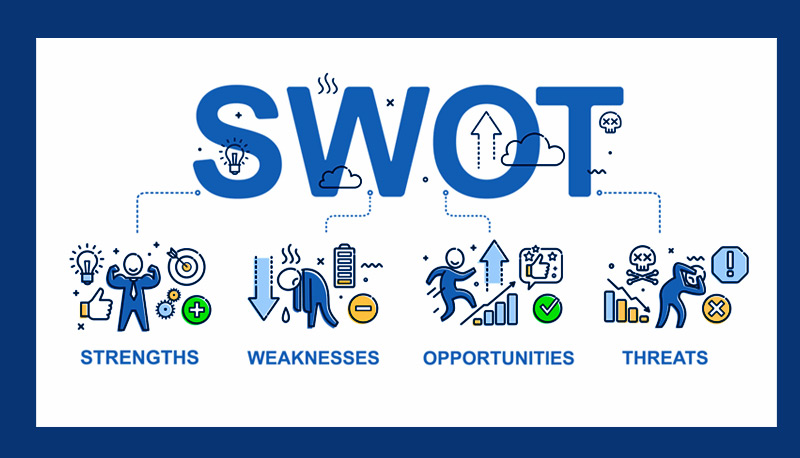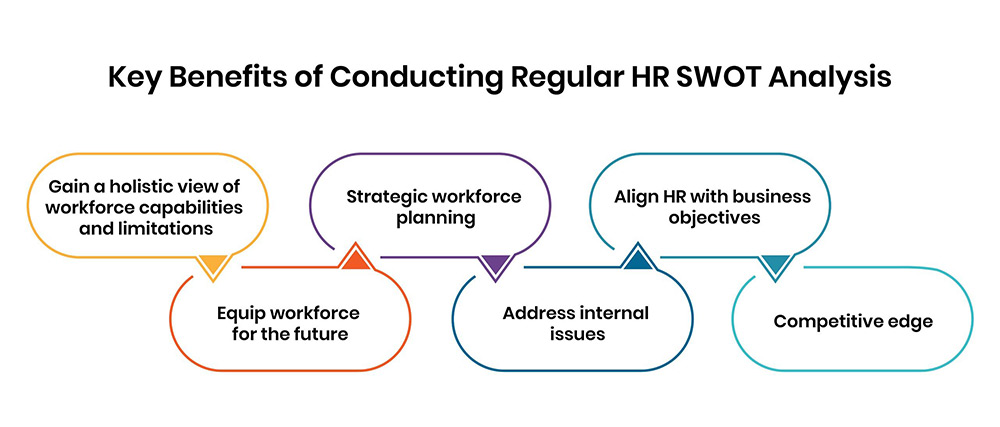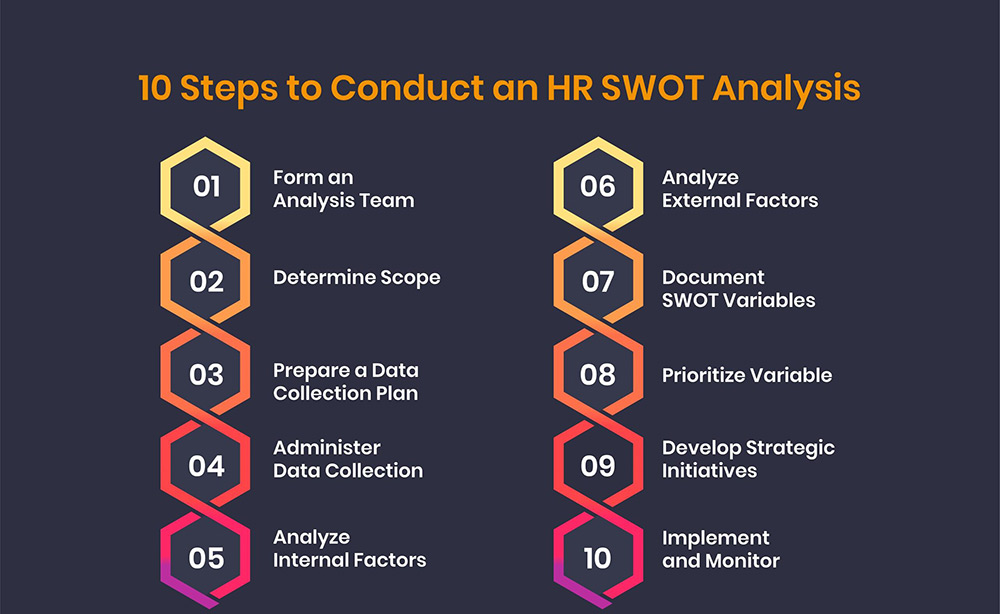
As HR leaders, performing regular analysis of our organization's human capital is crucial. A SWOT analysis is one of the most effective tools to evaluate the internal and external factors impacting our workforce. In this article, we will discuss a step-by-step guide to conducting a comprehensive HR SWOT analysis.
What is an HR SWOT Analysis?
A SWOT analysis is a strategic planning technique used to evaluate the Strengths, Weaknesses, Opportunities, and Threats involved in a project or business venture. The same concept can be applied to analyze an organization's human resources or 'people assets'. An HR SWOT analysis allows leaders to examine the internal and external environmental factors affecting workforce planning and development initiatives.
The internal factors - Strengths and Weaknesses are evaluated by considering employee competencies, organizational culture, resource availability, management practices, etc. Whereas external Opportunities and Threats arise from changing market trends, economic conditions, technological disruptions, and regulatory reforms impacting the labor market. Identifying these variables helps HR devise long-term people strategies aligned with business goals.
Why is an HR SWOT Analysis Important?
Regular SWOT analysis is important for several reasons:

-
Gain a holistic view of workforce capabilities and limitations: Analyzing strengths, weaknesses, opportunities, and threats gives HR a bird's-eye view of the present workforce landscape.
-
Strategic workforce planning: The insights help chart out future workforce needs, skills to develop, potential risks to address, and new avenues for talent acquisition and management.
-
Align HR with business objectives: Understanding the external environment and how it impacts people's strategies ensures HR initiatives are in sync with organizational priorities.
-
Equip workforce for the future: Mapping opportunities guide upskilling employees for changing job roles, succession planning and tackling competency gaps proactively.
-
Address internal issues: Focusing on weaknesses reveals areas that need improvement like inefficient processes, lack of skills, employee dissatisfaction etc.
-
Competitive edge: Benchmarking against industry trends and competitors highlights new practices to adopt for attracting and retaining top talent.
Conducting Regular SWOT Analysis
For SWOT analyses to add value, they must be conducted regularly, preferably every 6-12 months, to factor in changing business and market dynamics. Ad-hoc or one-time analyses may not provide a real-time pulse of the internal and external environments.
Some tips for effective periodic SWOT analysis:
-
Schedule SWOT sessions 2-4 weeks in advance for adequate planning and participation.
-
Include participants from different levels and functions like managers, and employees to gain diverse viewpoints.
-
Devise structured questionnaires or discussions centered around SWOT variables.
-
Analyze both quantitative and qualitative organizational data - feedback surveys, performance reports, market research etc.
-
Assign action items post-session with accountability and deadlines for follow-ups.
-
Track the progress of action plans, and revisit analysis periodically to refine strategies and basic learnings.
Steps to Conduct an HR SWOT Analysis
Here are the key steps to conduct a comprehensive HR SWOT analysis:

-
Form an Analysis Team
The first step is constituting a cross-functional team with representation from HR, different departments, and senior leadership. Their diverse expertise will offer a well-rounded perspective. As mentioned in the reference, effective HR SWOT analysis involves interdepartmental collaboration where different departments share their views.
-
Determine Scope
The team needs to define the scope of the analysis, such as a specific business unit, location, job families, etc. to focus the efforts. Broad scopes may miss actionable insights. The reference talks about various stakeholders being involved in the analysis including employees, management, industry etc. so it's important to identify the key stakeholders.
-
Prepare a Data Collection Plan
The team should decide on modes of collecting primary and secondary data through surveys, interviews, focus groups, reports etc. Questionnaires and discussion guides need to be designed. As per the reference, brainstorming sessions with stakeholders can help uncover strengths and weaknesses. Research is also needed to gather external factors.
-
Administer Data Collection
Questionnaires should be circulated and interviews/discussions conducted as planned, emphasizing participation and honest feedback. Internal departments need to share their perspectives openly. The reference emphasizes getting input from all sectors for a comprehensive understanding.
-
Analyze Internal Factors
The inputs need to be analyzed to identify organizational Strengths and Weaknesses concerning HR processes, culture, resources, skills, metrics etc. This involves understanding current advantages and limitations within the organization.
-
Analyze External Factors
Market and industry reports need research and peer benchmarking done to list out Opportunities and Threats from economic, social, technological or regulatory changes. The reference talks about performing research to gather data about external opportunities and threats objectively.
-
Document SWOT Variables
The consolidated inputs need to be systematically documented, listing all the Strengths, Weaknesses, Opportunities, and Threats identified with examples. This will help in prioritization.
-
Prioritize Variables
The variables should be ranked by significance/impact through team consensus to separate vital from routine matters. Important KPIs can be set as mentioned in the reference to back findings.
-
Develop Strategic Initiatives
Actionable initiatives need to be devised leveraging Strengths and Opportunities, and reducing Weaknesses and Threats. This involves creating strategic plans based on insights.
-
Implement and Monitor
Accountability and timelines need to be developed for implementation. Strategies should be continuously tracked, reviewed, and refined based on internal-external evolutions. Evaluation will help check changes requiring adjusted plans.
Tools to Augment SWOT Analysis
Leverage the following tools to boost the insights from HR SWOT analysis:
-
Survey Tools
Survey tools like Google Forms allow the designing and distributing of questionnaires to gather inputs from a large participant base for the SWOT analysis. Digital forms make participation easy from remote locations too. Insights from comprehensive surveys offer an authenticated 360-degree view of organizational strengths, weaknesses, opportunities and threats when clubbed with other tools.
-
Benchmarking Tools
Benchmarking software like CURA and Emergent help attain quantified, data-backed insights for the analysis. These tools aggregate anonymous data from partner organizations on varied HR parameters. Comparing metrics on performance, retention, learning indices etc. against industry peers highlights one’s relative positioning. Quantitative benchmarks spotlight potential areas of improvement along with best practices to emulate. They substantiate subjective inputs with objective market realities.
-
Focus Group Platforms
Virtual meeting suites like Zoom, Teams and Webex enable conducting remote focus group discussions to collect qualitative feedback. Breakout sessions with cross-functional employees, stakeholders and external experts provide diverse perspectives. Real-time group interactions allow exploratory discussions beyond restricted response options. Transcripts from these discussions offer contextualized quotes supporting identified variables.
-
Analytics Integration
Integrating data across HR systems like HRIS, LMS, and LXP using APIs allows gleaning metrics-driven insights. Parameters around hiring success rates, learning engagement, performance metrics etc. reveal prevalent trends. Statistical analysis of historical data profiles organizational factors. It facilitates fact-based identification of inherent strengths, recurring pain points and performance influencers.
-
Visual Mapping Tools
Software like MindMeister, Miro and Cacoo help create graphical representations of analyzed variables. These visual maps provide a ‘helicopter view’ of interdependencies between internal and external elements. It presents a unified, easy to comprehend picture for strategizing. Interactive visualizations also help structured documentation and consensus building across teams.
-
Prioritization Matrix
Prioritization frameworks like the MoSCoW Prioritization Matrix assist in determining the relative significance and feasibility of identified variables. Weighting inputs based on impact, risk, resource requirements etc. lays the groundwork for subsequent action planning. It guides the objective selection of quick wins vs long-haul improvements based on objective scoring.
Conducting SWOT for Specific Focus Areas
The HR SWOT analysis can also zoom into particular areas like:
-
Talent Acquisition SWOT Analysis
When analyzing talent acquisition, consider the sources and quality of candidates, branding efforts, and the overall candidate experience. Strengths may be diverse hiring channels that provide a large applicant pool. Weaknesses could be outdated hiring tools or an unfamiliar brand. Opportunities exist to partner with new schools or target specific demographics. Threats involve high competition for the best candidates or shifts in applicant preferences. The analysis would guide improvements to acquire top talent efficiently.
-
Learning and Development SWOT
For learning and development, evaluate training content and delivery methods. Strengths could be flexible e-learning options or mentorship programs. Weaknesses may be a lack of technical or soft skills training. Opportunities are emerging technologies that enrich learning. Threats involve budget cuts reducing training spending. The analysis could introduce changes to address skill gaps and optimize the learning process.
-
Performance Management SWOT
When assessing performance management, look at the evaluation system, metrics, and feedback culture. Strengths may be frequent check-ins and objective measures tied to goals. Weaknesses could be subjective ratings or inconsistent feedback practices. Opportunities include crowdsourced performance reviews. Threats involve disengaged employees distorting feedback or switching jobs for better career opportunities. The analysis would aid in enhancing the process for fair appraisals driving growth.
-
Compensation and Benefits SWOT
For compensation and benefits, examine the pay structure and market competitiveness. Strengths may be competitive salaries addressing local costs of living. Weaknesses could be a lack of performance-based pay or limited benefits. Opportunities are flexible arrangements like work-from-home and wellness programs. Threats involve the poaching of top talent by competitors providing higher compensation during economic booms. The analysis would help maintain compensation equity and optimize the offering.
-
Employee Engagement SWOT
When reviewing employee engagement, focus on surveys, retention efforts, and recognition programs. Strengths may be high participation in surveys creating transparency. Weaknesses could be low morale and high absenteeism. Opportunities are interactive goal-setting discussions that deepen connections. Threats involve disengaged or unhappy workers undermining team productivity. The analysis would aid in designing customized engagement initiatives for different worker segments.
-
Diversity and Inclusion SWOT
For diversity and inclusion, look at demographic representation and the potential for bias. Strengths may be diverse leadership and policies promoting fairness. Weaknesses could be the underrepresentation of certain groups in some roles. Opportunities are understanding the unique needs of different demographic segments. Threats involve discrimination lawsuits or losing talent due to prejudice. The analysis would help establish an equitable and respectful culture valuing all backgrounds.
Conclusion
Conducting an HR SWOT analysis with a focus on talent acquisition practices allows an organization to thoroughly evaluate its current strengths, weaknesses, opportunities and threats in the crucial function of attracting and hiring top talent. With the changing landscape of work and ongoing war for skills, continuously assessing and improving talent acquisition strategies is important for organizational success.
With insights from the focused SWOT, action plans can be formulated. For example, capitalizing on a strong employee referral program by incentivizing referrals even more. Addressing weaknesses like limited social media presence by developing comprehensive onboarding and campaigns. Seizing opportunities like offering signing bonuses to attract candidates in high-demand roles. Mitigation threats such as implementing competitive compensation by benchmarking salaries across companies.
Regular review and optimization of talent strategies informed by SWOT analysis will future-proof the talent supply chain. It will ensure an organization is maximizing strengths, efficiently resolving shortcomings, and proactively shaping opportunities for sustainable competitive advantage—even as the war for skills intensifies. Most importantly, it will keep the business equipped with the best talent to accomplish its objectives.




